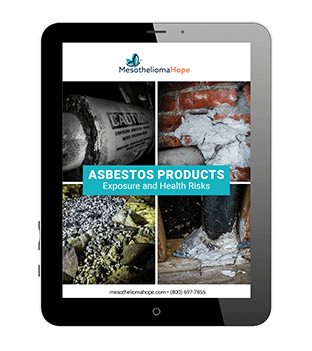Straight Talk about Mesothelioma, a blog series created by Michael T. Milano, M.D., Ph.D., a radiation oncology specialist, as a resource for mesothelioma patients and their loved ones.
While asbestosis and mesothelioma may seem similar, these 2 diseases are not the same thing. Asbestosis and mesothelioma are both caused by the inhalation of asbestos fibers, and therefore easily confused for one another. Asbestosis, however is not a cancer like mesothelioma.
Asbestos is a naturally-occurring mineral that is quite resistant to heat and corrosion. As such, it was once used widely to make products such as floor tiles, insulation, and even cement. Today, the use of asbestos is banned in over 50 countries, and in the U.S. asbestos is strictly regulated by the FDA due to its potential to cause adverse health effects.
What Is Asbestosis?
When asbestos fibers are inhaled, they accumulate in the lung and gradually start to destroy the normal lung architecture. This disease process is known as asbestosis. In asbestosis, the asbestos fibers gradually cause scarring of the lung(s), and, as a result, the lungs become stiff and are less able to expand. These lung changes can effectively suffocate the patient by preventing airflow and air exchange in the lungs.
What Makes Mesothelioma Different?
Different from asbestosis, which affects the lung directly, in mesothelioma, the asbestos fibers accumulate in the lining of the lung, which is called the “pleura.” In mesothelioma, the pleural lining initially develops a small pimple-like structure – known by doctors as a “nodule” – and this nodule then begins to develop into a thick sheet which, like asbestosis, can also prevent the lung from expanding.
The biggest difference between the 2 conditions – asbestosis and mesothelioma – is that asbestosis is a chronic disorder of the lung, whereas mesothelioma is a cancer.
Are the Symptoms of Asbestosis & Mesothelioma Different?
Another reason why these 2 deadly conditions are often confused, is because both diseases present with similar symptoms. For doctors, it is nearly impossible to tell, from just looking at the patient, what condition he or she has – and this is largely due to the fact that they both share a common cause.
The symptoms of both asbestosis and mesothelioma take a few decades to develop and may include some of the following symptoms:
- Dry cough
- Shortness of breath
- Loss of appetite
- Chest pains
In asbestosis, as the lung tissues get damaged, the individual has difficulty taking deep breaths. Over time, complications from asbestosis can occur such as:
- Heart failure
- High blood pressure in the lungs (pulmonary hypertension)
- Worsening of breathing
- Cancer
Why only certain people who are exposed to asbestos fibers develop mesothelioma is not yet very well-understood by the medical community. One should also be aware that in people who smoke, asbestos exposure can also increase the risk of lung cancer.
Is Asbestosis a Cancer?
The simple answer is: No.
Unlike mesothelioma, in asbestosis, there is progressive damage – or scarring – of the lung, but there is not necessarily a cancerous mass or masses. While the 2 diseases share the same risk factors, causes, and symptoms, mesothelioma is a cancer and asbestosis is not.
How Are the Diagnoses of Asbestosis and Mesothelioma Made and What Are the Treatment Options?
The diagnosis of mesothelioma requires a biopsy of a piece of the patient’s pleura (or lung lining). In asbestosis, the doctor will take a biopsy of the lung itself. In both cases, the tissues are examined under a microscope to confirm the diagnosis. Doctors will order a CT scan, chest x-ray, and lung-function tests to determine the extent and severity of disease.
Mesothelioma that is detected early is treatable with surgery and can sometimes be cured. More advanced stages of mesothelioma are treated with cancer drugs, but the chances of survival are unfortunately decreased. On the other hand, there are very few effective treatments for asbestosis. Once the lungs have been severely damaged by the asbestos fibers, all treatments available presently are “supportive.” What this means, is that the doctor will encourage his or her patients to eat healthy, use medications that can improve oxygenation, and encourage exercise. Patients with asbestosis usually require frequent chest x-rays and CT scans to monitor the progression of the disease. In rare cases, a lung transplantation may be done.
Is There a Difference in Prognosis between Asbestosis and Mesothelioma?
Asbestosis may not be a cancerous disease, but just like mesothelioma it can severely damage one’s quality of life. In terms of prognosis, most patients with asbestosis can live for many years after their diagnosis. Unfortunately, mesothelioma is a rare and very deadly cancer and its survival has been historically poor; though doctors and researchers are working hard to find different ways of treating this rare type of cancer caused by asbestos.
What many people do know is that the only way to prevent asbestosis and/or mesothelioma is to avoid exposure to asbestos fibers. This is why, if you or a loved one is experiencing any of the above symptoms, it is extremely vital that you talk to your physician about a past history of direct asbestos exposure or secondhand asbestos exposure.










